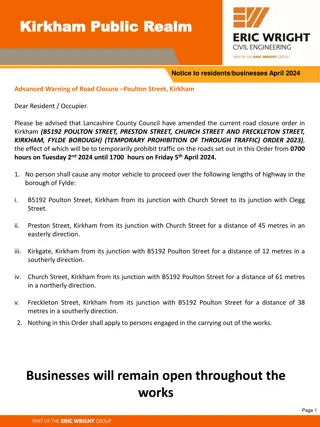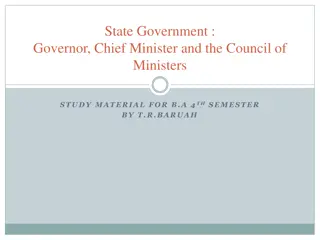The Lost Year: Governor Faubus and the Little Rock School Closure
In 1958-1959, Governor Orval Faubus made the controversial decision to close all high schools in Little Rock, resulting in the exclusion of 3,665 black and white students. This event, known as "The Lost Year," had a profound impact on the local community and highlighted the ongoing struggle for racial equality in education.
Download Presentation

Please find below an Image/Link to download the presentation.
The content on the website is provided AS IS for your information and personal use only. It may not be sold, licensed, or shared on other websites without obtaining consent from the author. Download presentation by click this link. If you encounter any issues during the download, it is possible that the publisher has removed the file from their server.
E N D
Presentation Transcript
Gov.Faubus Images from lost year.com June 9, 2016 THE LOST YEAR 1958-1959
ABOUT THE LOST YEAR During that year, Governor Orval Faubus closed all high schools in Little Rock, locking out 3,665 black and white students from a public education, and locking in almost 200 teachers and administrators to contracts to serve empty classrooms. Students and citizens were held in limbo. The 10th, 11th and 12th grades were closed. Faubus' school closing occurred at the beginning of the 1958-59 school year. Several weeks later a referendum was held and Little Rock voters, by a three-to-one margin, supported segregation over complete integration of all schools the only two options on the ballot. Faubus and segregationist state legislators created new state laws to further forestall court ordered racial integration of schools decreed in the 1954 Brown vs. Board of Education of Topeka.
DURING THE LOST YEAR For the second time in two years, many in Arkansas tried to assert state's rights over the authority of federal courts and the power of President Eisenhower. During the Lost Year, Little Rock was further torn by racial conflict, societal disruptions, and political machinations. Denying an education to all Little Rock high school youth profoundly affected thousands of families as the city ruptured into an even more divided community.
Jim Guy Tucker in Tampa, FL1958 Photo courtesy of the Center for Arkansas History andCulture Image from lost year.com June 9, 2016 THE STUDENTS Jim GuyTuckerandtheOthers
JIM GUY TUCKERS STORY For the 1958-1959 school year, Tucker lived with his Aunt Lillian and attended Hillsborough High School in Tampa, Florida. He was one of the fortunate Little Rock students as he still had access to a solid education, even getting to play on the Junior Varsity football team. His parents, obviously missing their son 900 miles away, corresponded frequently with Jim Guy and his Aunt Lillian. Their letters asked about his health and school life, but also relayed to him the state of affairs back in Little Rock. Jim Guy Tucker in Tampa, FL1958 Photo courtesy of the Center for Arkansas History andCulture
Jim Guy Tucker and his Aunt Lillian in Tampa, FL1958 Jim Guy Tucker in Tampa, FL1958 Photos courtesy of the Center for Arkansas History andCulture
LETTER FROM TAMPA, FL Photo courtesy of the Center for Arkansas History andCulture But you have no idea what our school situation is, just hope it does not get to Florida. People with children don t know how concerned you can get when it looks like a whole school year is being knocked in the head and they are not going to open schools here this year and maybe not for the next 3 or 4 years. The whole school system is shot. (Letter to Aunt Lillian from Willie Maude Tucker September 17, 1958) Directory Book
The Tampa Tribune interviewed Jim Guy about his experience as a displaced student. One of his concerns was not knowing where his fellow students were because not every family had the money or acquaintances to continue their education: You don t know where your best friend is now. He could be in Georgia, in the Army, or in school in some town near Little Rock. The ones who don t have enough money to pay tuition or go away are the ones really suffering. They re just not going to school. (Jim Guy Tucker undated) In fact, extremely poor families did not have that choice to send their children away so the children either took a job or dropped out of school altogether. The NAACP estimated that around 50% of the displaced African American students ultimately dropped out due to no viable alternative for them. Photo courtesy of the Center for Arkansas History andCulture
The students' stories are compelling. White students from Central High, Hall High, and Little Rock Technical High and black students from Horace Mann High scrambled to find an education. Fifteen and sixteen year old children had no access to local public education for an entire year. Many were forced to leave the state. Some studied to enter college early. Others boarded busses daily to travel miles for classes in other cities. Parents and siblings coped with separations from their teenage students who moved in with relatives or with friends around the state. Students, themselves, coped with life-changing disruptions from friends, family, and classes.
THESE COMMENTS COME FROM THE STUDENTS AFFECTED BY THE HIGH SCHOOL CLOSINGS: Roy Wade, a black junior, enrolled in nearby Wrightsville and recalled relationships within the overcrowded school: "We were able to establish some friendships with some of them, but they felt we were invading their space and their school and (we) hindered them because of the numbers. There were so many until it affected their education as well as our education."
Paul W. Hoover, Jr. was the son of aprominent Little Rock surgeon. Being white and from a financially secure family he was able to transfer to a private prep school for boys in Chattanooga, Tennessee. He doesn't remember being "necessarily pleased" with the decision, but Hoover now looks back and says: "It was the finest and best decision my parents ever made for me because it turned my life around. You had to study, you had to work for everything you got there."
Image from lost year.com June 9, 2016 Young boy watching school integration 1958
Toshio Oishi was a Japanese American whose family had been interned during WWII and later worked as laborers on a truck farm in Scott, AR. Because of declining enrollment, all Scott high school students were bussed to nearby schools in England or to Central High School in Little Rock during the crisis year of 1957 - 1958. Oishi's comments help explain the racial tone of the time. "I was very concerned during registration and prior to attending Central High of being given a difficult time because my skin was dark from working outdoors on the farm. This turned out to be an unwarranted fear."
Almeta Lanum Smith was to be a junior at Horace Mann High. Instead both she and her sister went to Pine Bluff (about 50 miles away) to attend a black Catholic high school. "We didn't have a car. We were just fortunate, we really were. We (my sister and I) went to St. Peter's in Pine Bluff. And the way we found out, a friend's father was working down there and he was going every day and coming back and Carmellita Smith was going with her dad and she and my sister were very good buddies. And so my mother asked if we could ride along with them. So that's what we did"
Edie (Edith Faye Garland) Barentine, a white senior from Hall High, was sent to Oklahoma to live with relatives for her senior year. Before, she was active in her church, served as a white counselor at an all black Methodist camp and participated in mixed-race discussion groups at the YWCA and in private homes. She remembered saying: If I ever come face to face with Orval Faubus he will hear what I think of him.' I wanted someone to blame for what happened in the Lost Year and what happened at Central High. Many, many years later I ended up alone on an elevator with him. He was much older. I noticed his suit was ill-fitting and his shoes were dirty. We made no eye contact, and in that short ride, I thought, 'this is a man and he is vulnerable, and he is old and tired.' And all of that hate just left me. His shoes were dirty and I had never stood in his shoes. As he exited the elevator, I looked at him and was able to say 'It's good to see you, Governor.
Image from lost year.com June 9, 2016 Closed Central High School1957
UNCERTAINTY It was a period unmatched in its peculiarities. Students had no schools to attend, but football continued at all campuses by suggestion ofthe Governor. The School District briefly experimented with live television teaching on local stations. A Private School Corporation for whites attempted to rent public school buildings and hire public school teachers, but federal courts restrained their efforts. Several private schools opened in alternative locations with alternative teachers and enrolled 44% of all the white high school students in Little Rock. Images from lost year.com June 9, 2016
NO MORE CHOICES Images from lost year.com June 9, 2016 Predictably, class and race were factors in who found schooling and who did not. Ninety three per cent of white students found some form of education that year. White families were better able to find transportation, pay tuition, or make more elaborate arrangements for alternative schooling. No private education emerged for blacks and fifty percent did no academic work that year. Many found jobs and hoped that schools would open, or joined the military to finish their education. Many of these students never returned to school. Ironically, the remaining members of the Little Rock Nine, having suffered through the previous year at Central, were also affected. Some left the state for alternative schooling or enrolled in correspondence courses from universities.
THE COMMUNITY Image from lost year.com June 9, 2016 Beyond the students, the community was in chaos. The Little Rock School District Superintendent and members of the School Board changed three times in one calendar year through resignations, appointments, and elections. State legislators expanded the troubles beyond Little Rock when they passed laws that targeted NAACP members and jeopardized the civil liberties of all teachers and professors. State employees were intimidated with requirements to list all organizations to which they belonged or to whom they paid dues. For months, the ever changing political upheaval of the community was measured by rising tensions and falling morale in every home of students, parents and teachers. Segregationist opponents formed CROSS (Committee toRetain our Segregated Schools) and attempted to recall the moderates on the school board. In a twenty day campaign, the opposing sides battled for the hearts of thecommunity.
Image from lost year.com June 9, 2016 STOP Moderates formed STOP (Stop This Outrageous Purge) to recall the segregationist school board members to try to regain control of their community and their public schools.
A TURNING POINT Opposing sides worked publicly and behind the scenes to jockey for control of their community. The Capital Citizens Council and the Mothers' League of Central High represented the segregationist groups. Few public voices stood for the moderates, but Harry Ashmore, Editor of the Arkansas Gazette, and The Women's Emergency Committee to Open Our Schools were among the first to have the courage to speak out. Finally in late spring a turning point came in the Lost Year crisis. At a session of the Little Rock School Board, which had gathered to consider renewing the teachers' contracts, three of the six member board walked out. These moderates considered this an end to the official business of the meeting, believing that no further action could be taken by the remaining segregationists.
A TURNING POINT (CONTINUED) However, the three remaining segregationists on the Board continued the session, and fired forty-four teachers and administrators who were believed to support racial integration. This purge served as a wake-up call to the city. Segregationist opponents formed CROSS (Committee to Retain our Segregated Schools) and attempted to recall the moderates on the school board. In a twenty day campaign, the opposing sides battled for the hearts of the community. People of Little Rock had to choose between keeping their beloved teachers and administrators, or bowing to the segregationists' purge. After a year of closed schools and the firing of teachers of both races, the voters of Little Rock narrowly recalled three segregationist School Board members, and the new Board opened schools early for the 1959-60 school year.
LESSONS OF THE LOST YEAR The disruptions of the Lost Year have had life-long consequences for former students and teachers, their families and the community of Little Rock. The lessons of the Lost Year, often unknown or little regarded, have much to teach us about public education and a community spirit that challenged segregation. The views of displaced students on race and desegregation were shaped by these events and have become life- longs beliefs. Perhaps most importantly, the Lost Year illuminates how the community took their schools back on an integrated basis and informs the world that all of Little Rock was not represented by screaming mobs of segregationists at Central High in 1957. Image from lost year.com June 9, 2016
SOURCES The James Guy Tucker, Jr. Papers Processing Project The Lost Year http://ualrexhibits.org/tuckerblog/ The Lost Year || About The Lost Year http://www.thelostyear.com/























